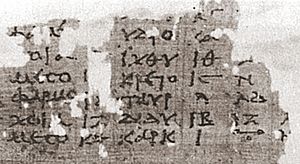Greek numerals facts for kids
Quick facts for kids Numeral systems by culture |
|
|---|---|
| Hindu–Arabic numerals | |
| Western Arabic Eastern Arabic Khmer |
Indian family Brahmi Thai |
| East Asian numerals | |
| Chinese Suzhou Counting rods |
Japanese Korean |
| Alphabetic numerals | |
| Abjad Armenian Cyrillic Ge'ez |
Hebrew Greek (Ionian) Āryabhaṭa |
| Other systems | |
| Attic Babylonian Egyptian Etruscan |
Mayan Roman Urnfield |
| List of numeral system topics | |
| Positional systems by base | |
| Decimal (10) | |
| 2, 4, 8, 16, 32, 64 | |
| 1, 3, 9, 12, 20, 24, 30, 36, 60, more… | |
Greek numerals are a way to write numbers using letters from the Greek alphabet. You might also hear them called Milesian numerals or alphabetic numerals. Today, in Greece, Greek numerals are still used for things like listing items (like "first," "second," or "Chapter III"). For everyday numbers, like counting how many apples you have, people in Greece use Arabic numerals, just like most of the world.
Contents
Early Ways to Write Numbers
Before the main Greek numeral system, there were other ways to write numbers.
Linear A and B Symbols
Very old Greek writing systems, called Linear A and Linear B, used simple symbols for numbers. They had special signs for 1, 10, 100, 1,000, and 10,000.
- A single line ( | ) meant 1.
- A dash ( – ) meant 10.
- A small circle ( ◦ ) meant 100.
- A cross in a circle ( ¤ ) meant 1,000.
- A sun-like symbol ( ☼ ) meant 10,000.
Attic Numerals
Another early system was called Attic numerals. This system worked a lot like Roman numerals, which actually got some ideas from it! It used the first letter of the number word to represent the number.
- Ι stood for 1.
- Π stood for 5.
- Δ stood for 10.
- Η stood for 100.
- Χ stood for 1,000.
- Μ stood for 10,000.
To make other numbers, they combined these symbols. For example, ΠΔ meant 50 (5 x 10).
The Ionic Numeral System
The Attic system was later replaced by a new system called the Ionic numeral system. This started around the 4th century BC. This system used letters for units, tens, and hundreds.
How it Works
In the Ionic system, each letter has a number value.
- The first nine letters of the alphabet stood for 1 to 9.
- The next nine letters stood for 10, 20, up to 90.
- The last nine letters stood for 100, 200, up to 900.
Since the Greek alphabet only has 24 letters, they needed three extra, older letters to make 27.
To show that a letter was a number and not just a word, they added a small mark called a "keraia" (κεραία) after it. It looks like an accent mark (ʹ).
Adding Numbers Together
This system works by adding the values of the letters together. For example, to write 241, you would combine the letter for 200, the letter for 40, and the letter for 1. So, 241 is written as σμαʹ (200 + 40 + 1).
| Letter | Value | Letter | Value | Letter | Value | ||
|---|---|---|---|---|---|---|---|
| αʹ | 1 | ιʹ | 10 | ρʹ | 100 | ||
| βʹ | 2 | κʹ | 20 | σʹ | 200 | ||
| γʹ | 3 | λʹ | 30 | τʹ | 300 | ||
| δʹ | 4 | μʹ | 40 | υʹ | 400 | ||
| εʹ | 5 | νʹ | 50 | φʹ | 500 | ||
| ϛ | 6 | ξʹ | 60 | χʹ | 600 | ||
| ζʹ | 7 | οʹ | 70 | ψʹ | 700 | ||
| ηʹ | 8 | πʹ | 80 | ωʹ | 800 | ||
| θʹ | 9 | ϟʹ | 90 | ϡʹ | 900 |
In modern Greek, people often use uppercase letters for numbers, like in Φίλιππος Βʹ for Philip II.
Higher Numbers
To write numbers from 1,000 up to 999,999, the same letters are used again. But this time, a "left keraia" (͵) is placed in front of the letter to show it means thousands. For example, 2008 is written as ͵βηʹ (2000 + 8).
The Greeks also had a special word, "myriad" (Μʹ), which meant 10,000. If they wanted to write one hundred million, they would write "myriad myriad" (ΜΜʹ).
| Decimal | Symbol | Greek numeral |
|---|---|---|
| 1 | Ι | ena |
| 5 | Π | pente |
| 10 | Δ | deka |
| 100 | Η | hekaton |
| 1000 | Χ | khilioi |
| 10000 | Μ | myrioi |
Images for kids
-
A 14th-century Byzantine map of the British Isles from a manuscript of Ptolemy's Geography, using Greek numerals for its grid lines.
See also
 In Spanish: Numeración griega para niños
In Spanish: Numeración griega para niños



